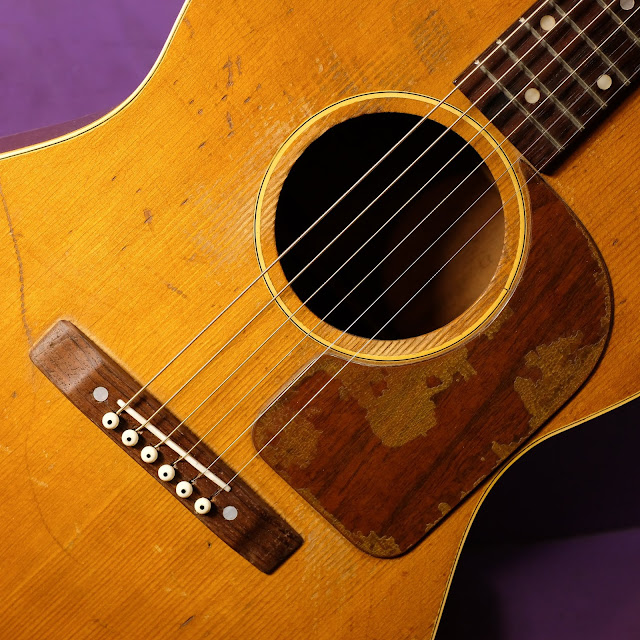1949 National 1160 (Gibson LG-3 Body) Flattop Guitar
So -- this is a killer guitar, to be frank. It's also one of those "original hodge-podge" Nationals with a Gibson-made body and National adjustable neck. The neck bears a 1949 National plate while the body's Gibson factory order number places it at 1948.
It's pretty hard to beat a late-'40s Gibson LG-2 or LG-3 body for that classic, dry, woody, ka-chunky old sound. I tend to favor them over J-45s or J-50s because of the size and articulation of the notes. You lose some bass and rumble compared to a J, but these bodies have kick and suit a great variety of styles more easily.
The National-necked versions (like this one) get mixed reviews, but I mostly think that's because folks aren't used to getting them dialed-in setup-wise. Once these are dialed-in, they sound almost the same as their actual-Gibson counterparts. National even used the same 24 3/4" scale length and -- up until '53 or so -- the same neck shape, sizing, and radius. To my hands, aside from the slightly larger frets (compared to period Gibson) and the fact that you have access right to the 14th fret with the no-heel design, this thing might as well be a '49 or '50 LG-3. The neck is cut just about the same.
Work included: a fret level/dress, pin-holes fill/redrill and reglue of the bridge, new compensated saddle, re-regluing of a couple of back braces, general cleaning, and a good setup. The neck is straight, action is spot-on at 3/32" EA and 1/16" DGBE at the 12th fret, and it's strung with 54w-12 gauges.
Scale length: 24 3/4"
Nut width: 1 11/16"
String spacing at nut: 1 7/16"
String spacing at saddle: 2 1/4"
Nut width: 1 11/16"
String spacing at nut: 1 7/16"
String spacing at saddle: 2 1/4"
Body length: 19 1/8"
Lower bout width: 14 1/4"
Upper bout width: 11"
Lower bout width: 14 1/4"
Upper bout width: 11"
Side depth at endpin: 4 3/8"
Top wood: solid spruce
Back/sides wood: solid mahogany
Neck wood: big magnesium core with mahogany wrapping
Fretboard: Brazilian rosewood
Back/sides wood: solid mahogany
Neck wood: big magnesium core with mahogany wrapping
Fretboard: Brazilian rosewood
Neck shape: 12" radius board with medium-C rear
Bridge: Brazilian rosewood
Nut: original bone
Condition notes: while there are no cracks on the instrument that I can find, it definitely has a ton of scratches and use-wear evident. It's all-original, too, save the two pearl dots and saddle at the bridge. I'm also pretty sure those pins are later, too.
The National logo's two attachment screws are probably replacements. Usually these have nails that tend to fall out or get really loose over time.
The headstock veneer is actually celluloid with a faux-grain pattern on its top edge. The neck-plate/cover is made of the same and the pickguard is, too.
There's only tiny wear to the board and there was not much fretwear to speak of. There's still good height to the frets and they feel a little more substantial than same-era Gibson frets, though they're small by modern standards. The dots are pearl.
The fretboard extension mildly "floats" above the top just a hair. There are concealed screws underneath two of the pearl dots that keep it snug to the top, however.
Check out how the finish has been mostly worn off of the pickguard! The stuff that remains has yellowed and checked. If one didn't want to see that finish on the guiard, it'd be easy-enough to chip it off the top of the faux-grain/celluloid pickguard and then buff it back up again -- though perhaps that's a bit criminal!
I love me some single-ring rosette!
The original bridge is in good health but does have a couple of chip-out repairs between string holes on its top. I also had to lightly-sand and then buff-up and add some finish to it to get it looking more normal as the top edge of it had yellowed/discolored significantly.
The pearl dots originally hid some bolts, too, but I removed them during reglue.
You can see that the mahogany back has a ton of use-wear in its numerous scratches.
The openback Kluson 3-on-a-strip tuners are working just fine.
Under the cool-looking neckplate hides the adjustment mechanism for the bolt-on neck. One big screw sets its tension/rigidity to the body, one small set-screw below it towards the back sets angle, and two set-screws near the top and at either edge set side-to-side angle. It's a genius system and works like a charm for easy adjustment through seasonal changes. I'd love to see a manufacturer make a modern version of this and incorporate an adjustable truss-rod in the neck as well.



















Comments